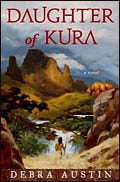Set a half-million years in the past, Daughter of Kura is the imaginative story of a young woman coming of age in a matriarchal culture in southeastern Africa.
Snap's species is Homo erectus, a forerunner of our own species, Homo sapiens. Adept with tools, she uses a digging stick to gather yams and a basket to carry and store them in. After she is injured fighting off a leopard attack, her problem is, to a Homo sapiens reader, both familiar and strange: "Blood soaked the hair of her arm and splashed into the last hole she had dug. The smell was strong and earthy, like a damp stream bank with an overturned slab of moss, the unmistakable odor of injury. Hyenas will scent that, even a morning's run from here, she thought."
This mingling of familiar and unfamiliar drives a well-paced, suspenseful story. Snap's struggle to survive and her yearning for community and affection are portrayed with great emotional immediacy. Although her matriarchal clan's customs are strikingly different from those of modern human societies, the consistency and realism of their portrayal makes them both convincing and fascinating. With only an archaeological record to work from, the author had to imagine, for the most part, the culture of Snap's people. She based it partly on what scientists have learned about spotted hyenas, which live in matriarchal clan groups that send males away at puberty to find mates in new clans.
Snap's people view their world in a practical, experiential way, following traditions that work for them and passing down stories that tell how past matriarchs solved challenges and guided the clan through difficult times. But when a male from far away arrives and the clan matriarch, Snap's mother, chooses him as her mate for the winter, he introduces the concept of a Great Spirit who must be propitiated to avert danger and bring good fortune. This theme links Snap's distant world with our own, warning of the risks that unquestioned, authoritarian religious beliefs may pose in any time. (2009; 310 pages, including a Author's Note discussing the factual and speculative underpinnings of the novel)




